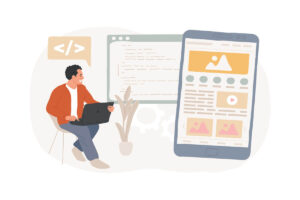In today’s fast-paced digital landscape, mobile app development has become a crucial aspect of businesses looking to stay ahead of the competition. As an executive overseeing a mobile app development project, it’s essential to understand the principles of Agile methodology to ensure the success of your project. This article will guide you through the key strategies and best practices for managing successful mobile app development projects using Agile.
Understanding Agile Methodology
Agile methodology is a project management approach that emphasizes flexibility, collaboration, and continuous improvement. Unlike traditional waterfall methodology, Agile breaks down the project into smaller, manageable tasks that are completed in short iterations known as sprints. This allows for rapid feedback, adaptation to change, and early delivery of value to stakeholders.
Key Principles of Agile Methodology
- Iterative Development: Work is divided into small iterations, allowing for incremental progress and feedback.
- Collaboration: Cross-functional teams work closely together to deliver the best possible product.
- Adaptability: Agile embraces change and allows for adjustments to be made throughout the development process.
- Customer Feedback: Regular feedback from customers and stakeholders ensures that the product meets their needs and expectations.
Agile methodology is based on the principles of flexibility, collaboration, and continuous improvement. By breaking down projects into smaller, manageable tasks and completing them in short iterations, Agile allows for rapid feedback, adaptation to change, and early delivery of value to stakeholders. This iterative approach ensures that the project stays on track and meets the needs of the end-users.
When implementing Agile methodology, it’s crucial for executives to embrace the key principles of Agile. This includes promoting iterative development, fostering collaboration among cross-functional teams, embracing adaptability to change, and actively seeking customer feedback. By following these principles, executives can effectively manage successful mobile app development projects using Agile methodology.
Implementing Agile for Mobile App Development
When applying Agile methodology to mobile app development projects, there are several key practices that executives should keep in mind:
1. Define Clear Goals and Objectives
Before starting the development process, it’s essential to define clear goals and objectives for the project. This includes identifying the target audience, defining the app’s features and functionality, and setting measurable success criteria.
2. Create a Cross-Functional Team
As an executive, it’s crucial to assemble a cross-functional team that includes developers, designers, testers, and product owners. This ensures that all aspects of the project are covered and that team members can collaborate effectively.
3. Prioritize Features and User Stories
In Agile development, features and user stories are prioritized based on their value to the end-user. Executives should work closely with product owners to determine which features are most important and should be included in the initial release.
When implementing Agile for mobile app development, executives should focus on defining clear goals and objectives, creating a cross-functional team, and prioritizing features and user stories. By following these practices, executives can ensure that the project stays on track and delivers value to stakeholders.
4. Embrace Continuous Testing and Feedback
Continuous testing and feedback are essential components of Agile development. Executives should encourage regular testing of the app’s functionality and usability and gather feedback from users to make necessary improvements.
5. Monitor Progress and Adapt as Needed
Throughout the development process, executives should monitor the team’s progress and make adjustments as needed. Agile allows for flexibility and encourages adaptation to changing requirements or priorities.
By embracing continuous testing and feedback, executives can ensure that the app meets the needs of the end-users and delivers a high-quality product. Monitoring progress and adapting as needed allows for flexibility and ensures that the project stays on track.
Best Practices for Executives in Agile Mobile App Development
To effectively manage a mobile app development project using Agile methodology, executives should follow these best practices:
- Provide Clear Direction: Communicate the project’s goals and objectives clearly to team members to ensure alignment and focus.
- Empower the Team: Trust your team members to make decisions and take ownership of their work. Encourage collaboration and creativity.
- Remove Roadblocks: Identify and address any obstacles that may hinder the team’s progress. Ensure that team members have the resources and support they need to succeed.
Executives in Agile mobile app development should provide clear direction, empower the team, and remove roadblocks to ensure the project’s success. By following these best practices, executives can foster a collaborative and innovative environment that leads to the delivery of high-quality mobile apps.
- Encourage Experimentation: Agile encourages experimentation and innovation. Allow team members to try new ideas and approaches to solve problems.
- Celebrate Success: Recognize and celebrate achievements and milestones throughout the project to motivate and inspire team members.
Encouraging experimentation and celebrating success are essential components of Agile mobile app development. By allowing team members to try new ideas and approaches, executives can foster innovation and creativity. Celebrating achievements motivates and inspires team members to continue delivering high-quality results.
By following these strategies and best practices, executives can effectively manage successful mobile app development projects using Agile methodology. By embracing flexibility, collaboration, and continuous improvement, businesses can deliver high-quality mobile apps that meet the needs and expectations of their users.
Ready to leverage Agile methodology for your next mobile app project? We can help! Contact us today to discuss your specific needs and how we can turn your app idea into a reality.
FAQs:
1. What is Agile methodology?
Agile methodology is a project management approach that emphasizes flexibility, collaboration, and continuous improvement by breaking down projects into smaller tasks completed in short iterations known as sprints.
2. What are the key principles of Agile methodology?
The key principles of Agile methodology include iterative development, collaboration, adaptability, and customer feedback to ensure incremental progress, cross-functional teamwork, flexibility to change, and meeting stakeholder expectations.
3. Why is it important to define clear goals and objectives in Agile mobile app development?
Defining clear goals and objectives helps identify the target audience, features, functionality, and success criteria for the project, ensuring alignment and direction for the team.
4. Why should executives create a cross-functional team in Agile mobile app development?
Assembling a cross-functional team with developers, designers, testers, and product owners ensures comprehensive project coverage and effective collaboration among team members to deliver the best possible product.











+ There are no comments
Add yours